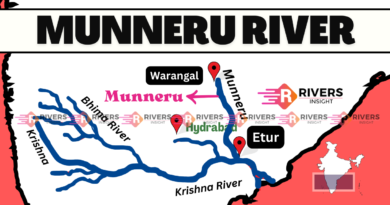Sankosh River with Map
The Sankosh River is a major tributary of the Brahmaputra River. It starts in northern Bhutan and flows into northeastern India. In Bhutan, the river is called “Puna Tsang Chu.” Meanwhile, its ecological contributions are vital to the region. Additionally, it plays a crucial role in the region’s water cycle.
Moreover, it is formed by the confluence of the Phochu and Mochu rivers in Bhutan. These snow-fed rivers originate from the Himalayan Mountains in northern Bhutan. This article will explore the Sankosh River in detail, covering its source, path, tributaries, and importance to the environment.
Table of Contents
Origin and Course
The Sankosh River originates in northern Bhutan, where it is fed by glacial melt and snow from the Himalayas. It flows approximately 214 kilometers southward through Bhutan before crossing into India, where it flows through the Dhubri district of Assam and empties into the Brahmaputra River at Gauripur.
Its catchment area is 12,061 square kilometers, excluding the Raidak River catchment, making it an important part of the region’s water system.
Tributaries of the Sankosh River
Mo Chu (Mochu)
- Originates from the high altitudes of Bhutan
- Flows southward, contributing significantly to the Sankosh’s flow
- One of the two largest tributaries of the Sankosh River
Pho Chu (Phochu)
- Originates in Bhutan
- Joins the Sankosh River
- Upper courses are known for ice blockages, which can impact water flow and create seasonal variations
River Systems in Bhutan
There are six major river systems in Bhutan, which drain water from different parts of the mountain ranges in a north-south direction into the Brahmaputra River system. These rivers are:
- Torsa (Amo chu)
- Raidak (Thimpu chu/ Wang chu)
- Sankosh (Mo Chu)
- Mangde Chu
- Bumthang
- Kuru Chu and Manas (Kulong chu)
The Sankosh River, also known as Mo Chu, is one of the major tributaries of the Brahmaputra River, draining the valley of Punakha in Bhutan.




